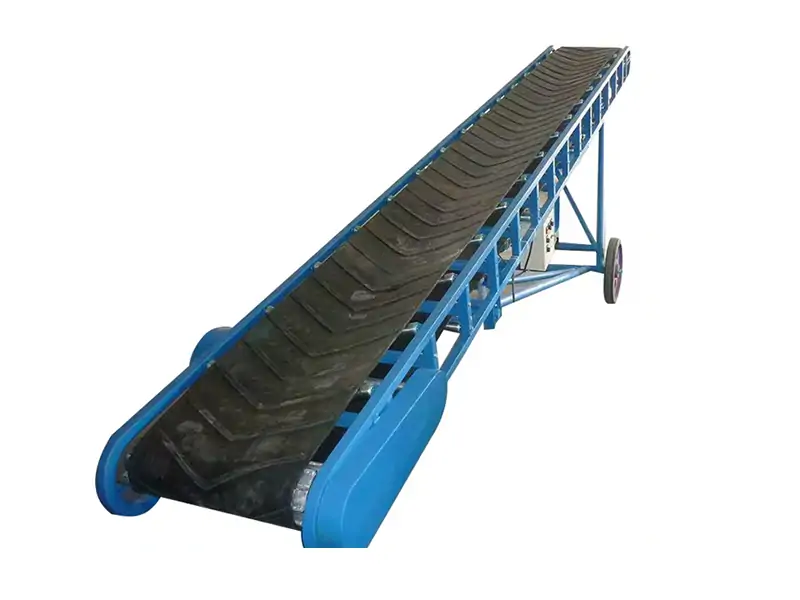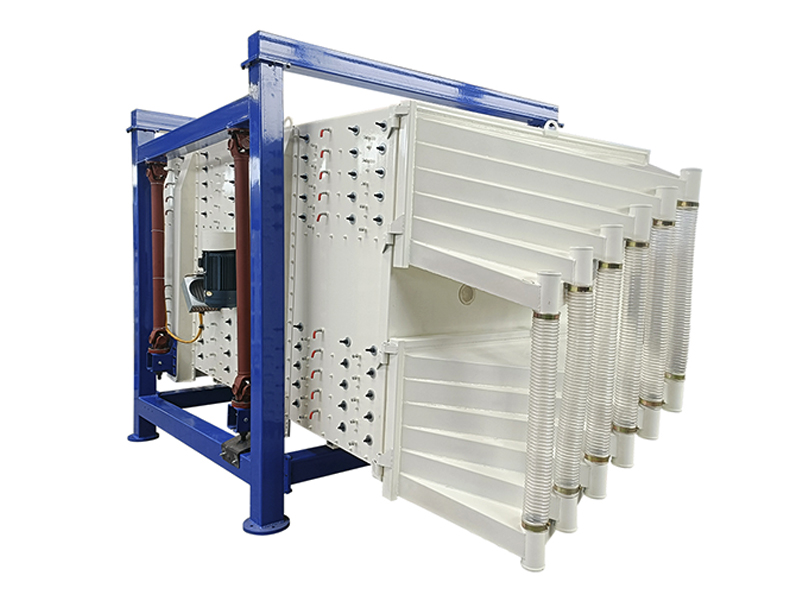The sand conveyor belts are widely used in mining, construction, agriculture and other fields. Different conveyor belt types, materials, and working environments will directly affect the conveying efficiency and long-term stability of the system. So, how can we choose the most suitable sand and gravel conveyor belt? In the following content, we will explore in depth the various types of sand and gravel conveyor belts, price ranges, and how to make the best choice according to actual needs. Through this article, you will get a one-stop guide to selecting sand and gravel conveyor belts. Please continue to follow us to explore more details together.

What is a sand conveyor belt?
The sand conveyor belt is a heavy mechanical equipment used to transport sand, stone, ore, and other materials. The conveyor belt is driven by a driving device and the material is transported by a roller. When the driver is started, the belt starts to move, and the material is placed on the belt and transported to the designated location.
The sand conveyor belt has the advantages of simple structure, economical and convenient, stable transmission, large conveying capacity, and low noise. The sand conveyor belt can be made into climbing, turning, side bending, horizontal, and other forms according to the use conditions to meet different working environments and transportation needs.
Different Types of sand conveyor belt
Sand conveyor belts can be divided into the following types according to different conveying angles and installation design functions:
The sand and gravel conveyor belt of angles

Horizontal Sand and gravel conveyor belt 
Inclined Sand Conveyor Belt
Horizontal sand conveyor belt:
Widely used in mining, building materials, chemical industry, and other fields. It has the advantages of long conveying distance, large conveying capacity, and smooth running. It can be adapted to different conveying speeds and throughput needs and can be customized according to needs.
Inclined sand conveyor belt:
A material conveying equipment used to transport sand stone and other bulk materials from low to high places. It can adapt to different tilt angles and conveying speeds to meet the needs of material conveying in a variety of complex environments. It is necessary to pay attention to factors such as particle size, humidity, and abrasive resistance.
Different functions of sand conveyor belt
In terms of functional selection, there are two different types of sand and gravel conveyor belts: fixed and mobile. Each type of conveyor belt has its own unique advantages and is suitable for different working environments.

Fixed Sand Gravel Conveyor Belt 
Mobile Sand Conveyor Belt
Fixed sand conveyor belt:
The utility model relates to fixed equipment specially used for conveying bulk materials such as sand and stone. The fixed installation layout is usually installed on the ground or inside the building, which is suitable for long-term and stable material transportation needs. Widely used in mining, building materials, and other industries of material transportation.
Mobile sand conveyor belt:
An efficient and flexible conveying equipment, which is specially used for conveying bulk materials such as sand and stone. The most striking feature is its mobility. It is suitable for occasions where the conveying position needs to be changed frequently or for temporary projects.
Working Principle
The sand conveyor belt usually consists of a conveyor belt, a drive device, a roller (including the driving roller and roller), a frame and necessary devices, protective devices, etc. The power is transmitted to the driving roller through the reducer. Its working principle is to use the friction between the conveyor belt and the transmission roller and the supporting effect of the roller. The driving roller starts to rotate after being driven by the power, driving the conveyor belt to move. Under the guidance of the roller and the rack, the conveyor belt moves continuously along the predetermined track to transport materials such as sand and gravel to the desired location.

The applications of sand conveyor belt
- Construction industry: In the production and processing of building materials, sand, and gravel belt conveyors are widely used to transport sand, gravel, concrete, and other materials.
- Mining operations: In the mining industry, the sand belt conveyor is used to transport ores, mineral powder, and other materials from the mine to the ground, or to carry out material transmission between different processes.
- Coal industry: In the process of coal mining and processing, sand and stone belt conveyors are used to transport coal from the mine to the coal washing plant, or to transport the washed coal to the coal storage yard.
- Metallurgical industry: In the metallurgical industry, the sand and stone belt conveyor is used to transport and stack metal ores, smelting slag, and other materials.
- Road laying: In road construction, sand belt conveyor is used to transport sand, asphalt, and other materials to the construction site to support road laying and maintenance work.
The Price of sand and conveyor belt
| Model | Belt width(mm) | Length (m) | Power(kw) | Speed(m/s) | Amount(t/h) | Price(4/set) |
|---|---|---|---|---|---|---|
| Horizontal sand conveyor belt | B500 | 3 | 4-7.5 | 1.25-2.0 | 40-80 | $2120-10750 |
| Inclined sand conveyor belt | B650 | 3 | 7.5-11 | 1.25-2.0 | 80-120 | $4100-24230 |
| Vertical sand conveyor belt | B800 | 4 | 7.5-15 | 1.25-2.0 | 120-200 | $5500-36300 |
| Fixed sand conveyor belt | B400 | 3 | 4-7.5 | 1.25-2.0 | 30-60 | $2000-9430 |
| Mobile sand conveyor belt | B1000 | 5.5 | 7.5-22 | 1.25-2.0 | 200-320 | $14800-249000 |
The price and specification of sand gravel conveyor belts can vary widely based on several factors:
- Model: Different types of belt conveyors have different conveying capacities and scope of application, which directly affects the manufacturing cost and price of the equipment.
- Materials, such as rubber, nylon, etc., different materials have different wear resistance, tear resistance, and service life, which affects the price and specification.
- Configuration: Whether the roller is coated, the number of rollers, the number of bars, and other configurations will also affect the price.
Customized belt conveyor options
- Water removal device: used to remove rain and snow water on open-air horizontal belt conveyors to prevent belt slippage.
- Sharp debris removal device: When conveying more complex materials, this device can be installed to prevent the conveyor belt from being scratched and torn.
- Enclosed cover: Adding a closed cover can reduce the damage to the conveyor belt caused by wind, rain and sun, and increase the service life of the belt conveyor. At the same time, if the conveyor is a powdery material, the closed cover can also prevent dust from polluting the environment.
- Water washing device: In order to conveniently and quickly remove the residual materials after the conveyor belt is stopped, a water washing device can be installed. At the same time, the belt conveyor cleaner still needs to be configured.
- Sound and light alarm device: When the conveyor belt needs to work continuously for a long time or the conveying distance is relatively long, the installation of a sound and light alarm device can give an early warning to avoid accidents and improve safety.
- Support device: such as rollers, used to support the conveyor belt, limit the verticality of the conveyor belt, and ensure that the conveyor belt can operate normally.
- Hopper: used to concentrate and guide materials onto the conveyor belt to improve the material transportation efficiency.
- Skirt: installed on both sides of the sand and gravel conveyor belt to prevent materials from slipping off the sides of the belt during transportation.
- Material guide trough: used to guide the flow direction of materials on the conveyor belt so that the materials can be accurately transported to the designated location.
- Deviation correction device: used to automatically adjust the running direction of the conveyor belt to prevent the conveyor belt from running off the track.
- Braking device: such as belt stopper, roller check and electromagnetic brake shoe brake, etc., used to stop the movement of the conveyor belt when needed to prevent the backflow of materials or excessive wear of the sand conveyor belt.
Conclusion:
When choosing the type of sand conveyor belt, please consider your production line layout, belt conveyor configuration and budget to find the most suitable sand conveyor belt. Sanyuantang is a professional vibration and conveying equipment factory. We have rich experience in production and design. If you have any needs, please contact us to customize the right solution for you.
Related Products
Blogs
- The Role Of Sand Conveyor Belt In Sand Making Plant
- Sand Conveyor Belt Types And Price
- Understanding The Inclination Angle Of Belt Conveyors
- Chain Conveyor VS Belt Conveyor
- The Role Of Dewatering Vibrating Screen In Sand Production Line?
- Application and Principle of Grain Belt Conveyor
- The Most Commonly Used Mobile Conveyor Belt













